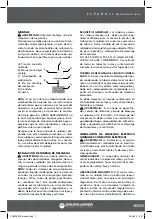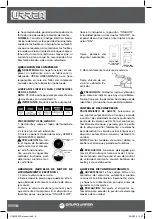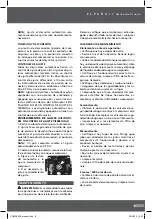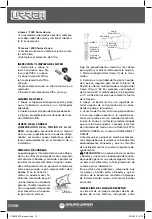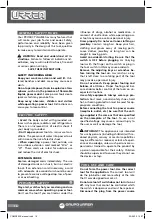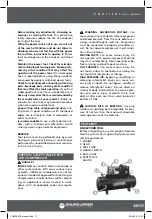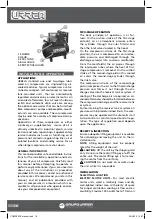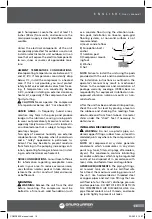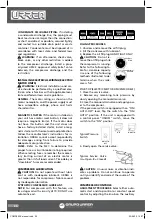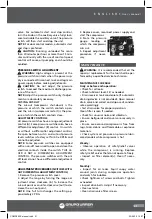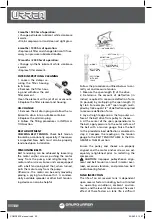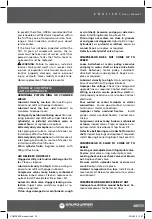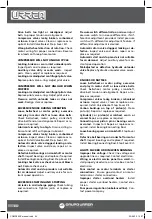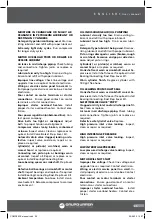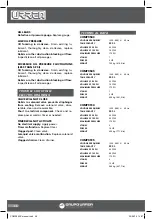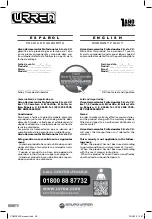
21
E N G L I S H •
User’s manual
valve. For automatic start and stop control,
turn the knob on the auxiliary valve fully clock-
wise to disable the auxiliary valve. The pressure
switch will then start and stop the unit.
NOTE: For dual control models, automatic start
and stop is preferred.
CAUTION: Running unloaded for more
than 20 minutes per hour or more than 15 min-
utes continually with the use of constant speed
control will cause oil pumping and should be
avoided.
PRESSURE SWITCH ADJUSTMENT
WARNING: High voltage is present at the
pressure switch contacts when the power sup-
ply is connected. Disconnect, lock and tag main
power supply before making adjustments.
CAUTION: Do not adjust the pressure
switch to exceed the maximum discharge pres-
sure of the unit.
NOTE: Adjust the pressure switch only if adjust-
ments are absolutely necessary.
CUT-IN & CUT-OUT
The cut-out (compressor shut-down) is the
pressure at which the switch contacts open,
and the cut-in (compressor restart) is the pres-
sure at which the switch contacts close.
ADJUSTMENT CONTROLS
All pressure switches have a range adjustment
control (A). Some pressure switches also have a
differential adjustment (B) control. On switch-
es without a differential adjustment control,
the span between cut-in and cut-out pressure
levels switches is factory set for 40 ± 4 PSIG and
cannot be adjusted.
NOTE: Some pressure switches are equipped
with an on-off lever used to open and close the
electrical contacts inside the switch. THIS LE-
VER IS NOT A DIFFERENTIAL ADJUSTMENT
CONTROL. The pressure switches with the on/
off lever do not have a differential adjustment
control.
ADJUSTMENT PROCEDURES
(SWITCHES WITH-
OUT DIFFERENTIAL ADJUSTMENT CONTROL)
1. Remove the pressure switch cover.
2. Adjust the range by turning the range ad-
justment screw clockwise (in) to increase the
cut-out point or counter-clockwise (out) to de-
crease the cut-out point.
NOTE: One full turn changes the setting ap-
proximately 2 PSIG.
3. Replace cover, reconnect power supply and
start the compressor.
4. Note the pressure
gauge reading at
which the compressor
cuts out.
5. Repeat adjustment
procedure if neces-
sary.
MAINTENANCE
WARNING: It is recommended that all the
repair or replacement for the tool shall be per-
formed by a qualified service technician.
MAINTENANCE SCHEDULE
Daily or before each operation:
• Check for oil leaks.
• Check lubricant level. Fill as needed.
• Drain receiver tank condensate (if automatic
draining device is not provided). Open manual
drain valve and collect and dispose of conden-
sate accordingly.
• Test drain valve for proper operation.
Clean filter screen if needed.
• Check for unusual noise and vibration.
• Ensure beltguards and covers are securely in
place.
• Ensure area around compressor is free from
rags, tools, debris, and flammable or explosive
materials.
• Check system oil pressure on pressure lubri-
cated models while compressor is hot.
Weekly:
• Observe operation of safety/relief valves
while the compressor is running. Replace
safety/ relief valves that do not operate freely.
• Inspect air filter element(s). Clean if neces-
sary.
Monthly:
• Inspect for air leaks. Squirt soapy water
around joints during compressor operation
and watch for bubbles.
• Check tightness of screws and bolts. Tighten
as needed.
• Inspect drive belts. Adjust if necessary.
• Clean exterior.
• Clean drain valve filter screen.
COMP95XX manual.indd 21
23/06/15 14:27

